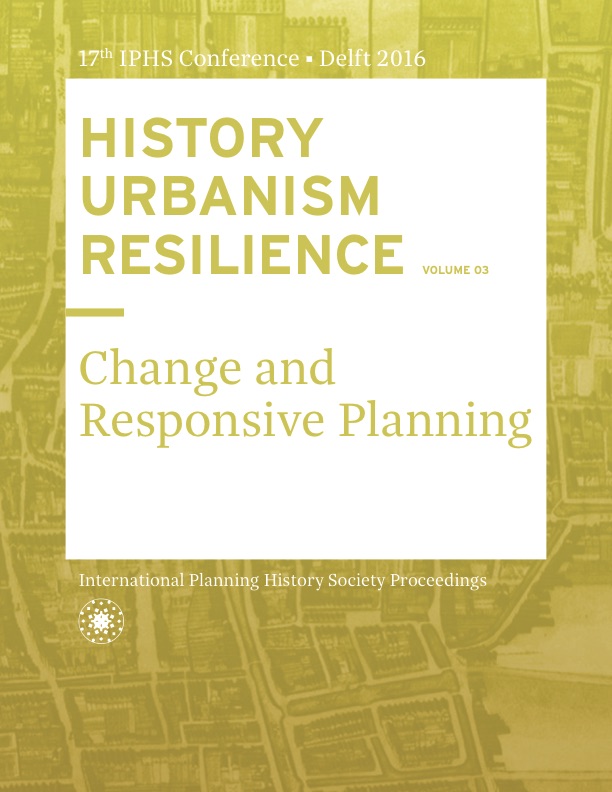Understanding vulnerability of historic urban sites
DOI:
https://doi.org/10.7480/iphs.2016.3.1351Abstract
Turkey, located in an active part of the Alpine-Himalayan belt, is a vulnerable country that faces a major earthquake on an average of every year and a half. In Istanbul, during the last 500 years, several devastating earthquakes had occurred. The earthquakes in August 1509, April 1557, July 1690, May 1766 and July 1894 were recorded with massive social - economic depressions and physical destructions. Besides the significant amount of deaths in each earthquake, monumental buildings and civil architecture listed as country's cultural heritages; the City Walls, the Topkapi Palace, the Aga Sophia, the Fatih Mosque, the Grand Bazaar and thousands of residents and inns, were damaged and needed to be reconstructed.Addition to these major earthquakes, numbers of great fires had impaired the city. In 1729, one great fire had destroyed one – eighth of the Istanbul from the gate of Fener to Ayvansaray. Between 1782 and 1784, serial fires occurred in Istanbul. Beyoglu, Galata and Karakoy districts burnt completely in the Great Beyoglu Fire in 1870. Destructions were triggered new development decisions and preventive implementations. After each disaster, more innovative techniques and durable materials were used in reconstruction processes; also, the urban pattern was confronted with alterations according to the needs of the recovery phase, for instance, evacuation and temporary accommodation for disaster survivors.
Cultural and natural heritages are not only under the pressure of rapid urbanisation or prone to deterioration, change and disappearance but also vulnerable to disasters such as ground motion due to earthquakes and fires. Non-negligible efforts have been made to prevent physical damage and minimise the number of possible deaths especially in the urban historic sites in Turkey. Principles, to redefine goals, strategies and implementation for risk mitigation, have been developed
.
This paper focuses on great disasters that threatened the urban fabric in the history of Istanbul and still threatens the urban conservation sites. It aims to lead a discussion on how to continue conservation studies to risk preparedness and preventive care for Turkey’s cultural heritage. In this study initially, post – disaster assessment literature in urban conservation sites are investigated to comprehend recovery phases of the last 500 years’ major disasters and highlight the vulnerability of urban conditions. Risk prevention and mitigation principles consisting structural peculiarities, physical density, open space network and routes for evacuations will be discussed based on the old site plans of Istanbul the years between 1500’s and 1900’s. Lastly, alternative interventions for historic urban sites conservation under the disaster risk will be discussed with case studies in urban planning, urban conservation and architectural design tools.
References
Ambraseys, N.N. and Finkel C.F. “The Marmara Sea Earthquake of 1509” Terra Motae 2(1990):2. 110-190.
Bareilles, B. Istanbul’un Frenk ve Levanten Mahalleleri: Pera – Galata – Banliyöler (Istanbul: Güncel Publishing, 2003) 47.
Cezar, M. “Osmanlı Devrinde Istanbul Yapılarından Tahribat Yapan Yangınlar ve Tabii Afetler” Türk San’atı Tarihi Araştırmaları ve İncelemeleri (1963) 327 – 414.
Celik, Z. The Remaking Of Istanbul: Portrait Of An Ottoman City in the Nineteeth Century (Berkeley: University of California Press, 1993).
Demirelli, K. “İstanbul’da Meydana Gelen Büyük Depremler ve İstanbul’un Geoteknik Açıdan İncelenmesi” (Master Thesis, Istanbul Technical University, 2001). 85.
Feyzioğlu, H., S. “1894 İstanbul Depremi Hakkında Bir Rapor Üzerine İnceleme”, Ankara Üniversitesi Dil ve Tarih-Coğrafya Fakültesi Tarih Bölümü Tarih Araştırmaları Dergisi 19 (1997): 29. 171-172.
Gursu, B. and Dogan, E. Maps of Beyoglu (Istanbul: IMM, 2012) 25.
Istanbul Metropolitan Municipality (IMM) and Construction Directorate Geotechnical and Earthquake Investigation Department (IDMP). Earthquake Master Plan for Istanbul (Istanbul: IMM Publishing, 2003).
Japan International Cooperation Agency (JICA) and Istanbul Metropolitan Municipality (IMM). The Study on a Disaster Prevention / Mitigation Basic Plan in Istanbul Including Seismic Microzonation in the Republic of Turkey (Istanbul: IMM Publishing, 2002). 649.
Mazlum, D. 1766 İstanbul Depremi: Belgeler Işığında Yapı Onarımı (Istanbul: Istanbul Arastirmaları Enstitute Publisihng, 2011). 42.
Pervititch, J. Jacques Pervititch Sigorta Haritalarında İstanbul (İstanbul: Tarih Vakfı Yayınları, 2003).
Sabancioglu, M., and Vekaric, N. “Dubrovnik’ten İstanbul’a Jaques Pervititch ve Ailesi”, Tarih ve Toplum 226 (2002): 38.
Sakin, O. “Afetlerin Gölgesinde İstanbul”, in Osmanlı Döneminde İstanbul’da Deprem, ed. Ozturk, S. (Istanbul: IBB Publishing, 2009). 351.
Sezer, H. “1894 İstanbul Depremi Hakkında Bir Rapor Üzerine İnceleme” Ankara Üniversitesi Dil ve Tarih-Coğrafya Fakültesi Tarih Bölümü Tarih Araştırmaları Dergisi 19 (1997): 29. 171 – 172.
Slot, B. J. “The Fires in Istanbul of 1782 and 1784 According to Maps and Reports by Dutcy Diplomatic Representatives” Güney – Doğu Avrupa Araştırmaları Dergisi 4 (1976). 47-65.
Stowel, H. Risk – Preparedness: A Management Manuel for World Cultural Heritage (Rome: ICCROM, 1998).
Ozata, S. and Limoncu, S. “16. ve 20. yy Arası İstanbul ve Yakın Çevresinde Meydana Gelen Deprem Sonrası Barınma Uygulamalarının İncelenmesi” Megaron 9(2014) 3. 217-227.

